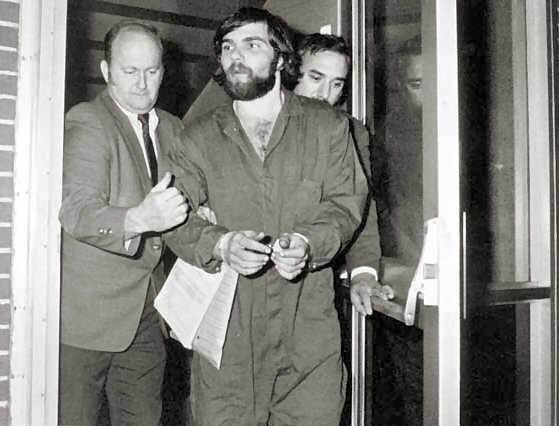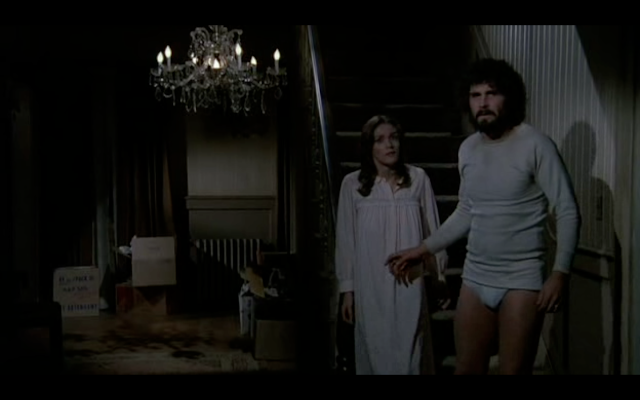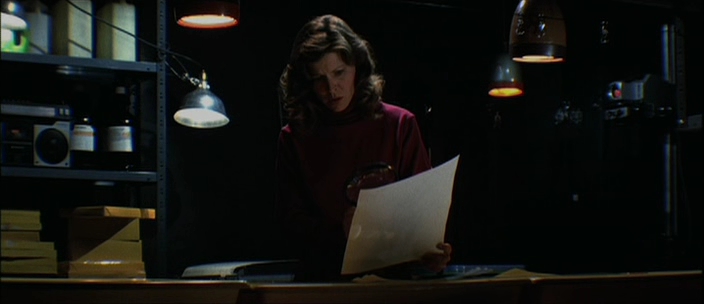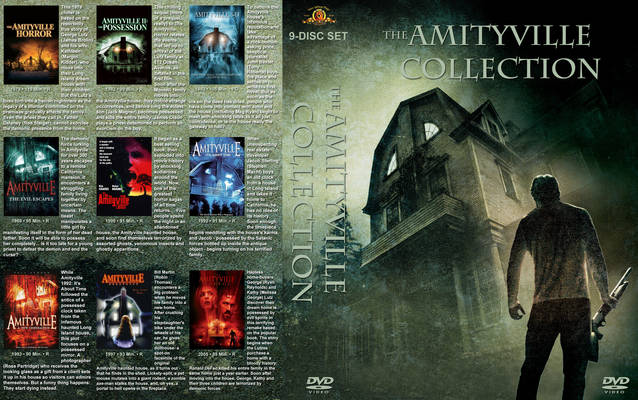Reality vs. Bullshit
The only fact about any of the Amityville Horror films is that the DeFeo family was murdered in their sleep inside the house on 112 Ocean Avenue. The real horror is what the surviving relatives of the murdered Defeo’s must endure every time one of these lousy films is made.

Hollywood cynicism goes beyond making bad films and trying to pass them off as good or worse yet, classics. The real cynicism is from the studios that torture the DeFeo family and make a buck off a terrible situation. As a result, I wonder, has any studio that made these films ever donated a few posthumous bucks to the DeFeo family for their trouble? I’m not one for reparations, but many of these films invoke the DeFeo name. Maybe a scholarship or two set up in memory of the victims? A lot of people made a lot of money off this family’s tragedy. As a result, they might be owed something.
There isn’t one good film in this series. Not a single one.
As I write this, the word is out that the sequel to the mega hit, The Conjuring will involve the Amityville incident. Why do the Amityville films count as Cynema? I’m looking at the original three and the 2004 remake for this article.

The real Amityville home in the 1970s.
There’s Money In Ghosts
If you’re a real horror fan, the kind that knows the difference between the good, the so bad it’s good and the shit; you know there isn’t one good film in this series. The franchise gets a free pass in a similar way the Halloween franchise receives one. The sad part is that all of the ingredients were there to make one hell of a haunted house movie. Robert Wise’s The Haunting (not the terrible Liam Neeson remake) is considered THE haunted house movie to this day. I’m not so sure I agree with that, and if the 1981 The Changeling focused on the house a bit more, it would wrestle that title away. There’s The Legend of Hell House, but that falls apart about fifteen minutes into the film.
For me, Jaws is the definitive shark movie. The Jaws of haunted house movies has yet to be made.
Carpenter’s 1978 classic was never meant to be a franchise. Its 1981 sequel is a retread–a rip off film that fans revere because it takes place on the same night and Jamie Lee Curtis returned. The film offers nothing new and while well made, it’s an inept film and poor sequel. It gets a free pass from fans who blindly embraced parts 4-6. These were knockoff films. H20 (See my entry on designer 90s horror here) was an overrated mediocre effort because Curtis returned to the well. The last entry, known as “The Tyra Banks One” is dreadful. The Rob Zombie films are a different matter.

All new! All new! Not really.
The Amityville films get a similar undeserved reverence, but are more of a cinematic affront than the Halloween sequels. The sad part is that each of the following films had opportunities, brief ones, where they could have been good.

Slim Pickings
There aren’t many good haunted house movies. Amityville is a kind of a brand because of its “true story” that has been debunked numerous times. Folks still want to believe, but there is more evidence supporting hoax than horror.
Here are some highlights:
Despite the fact that The Lutz’s (who claimed to have fled the house 28 days after moving in) own lawyer, William Weber, admitted the whole thing was made up over bottles of wine; the legend persists.

Ronald DeFeo, the murderer who shot his family, has told numerous shifting accounts of that evening. He’s changed the story to fit his case, but has admitted he heard no voices and nothing supernatural provoked him to kill his parents and siblings. He made that shit up for a failed insanity plea.

The post-incident owners of the house (there have seen several) have publicly stated they experienced zero issues aside from souvenir hunters and trespassers.

The priest who allegedly heard the infamous “Get Out!” has declared he heard nothing and distanced himself from the whole affair.

Rod Steiger (l) as the priest and the real guy (r) shadowed for an interview.
The late Jay Anson, author of the bestseller that launched this claptrap, admitted that he took liberties with the story to make sure it had a good narrative.
Translated: he made shit up.
They’ve been remaking the same damned story since 1979. Can someone do it right, even if it is all bullshit?
Here is why the series is Cynema.
The Amityville Horror 1979

The Book
The book was a monster bestseller. The nation was captivated by the “Empire State Building” of haunted houses in quiet Long Island. Famed B-movie company American International Pictures (AIP), under the guidance of schlock meister, Samuel Z Arkoff got the rights to the book and spent no time or expense in making a poorly made film.
They had the blueprint: just translate the book. That’s all they had to do. Like the cynical Halloween II, this was going to make money. Why not give a little effort and make a good movie, regardless of being a true story or not?
AIP approved a poor script with laughable dialogue and almost no resemblance to the book. If you have a haunted house movie, you would think ghosts would be scary enough. The screenwriter didn’t think so.
For some reason, the house has to fall apart at the end. This will become a trend in the series. The house explodes, windows and doors shatter, walls collapse…lots of crash and boom. Aren’t the ghosts enough? Why does a demolition team need to be brought in?
I saw this in theaters in 1979 on its opening weekend. I was 12 years old. During the film’s crash and boom ending a woman seated behind us said to her husband: “My God, I hope they have home insurance.” That was the horror to her. Not ghosts. The film brought more chuckles than it did screams from the audience I saw it with.

Brolin those jockeys is pretty scary. I’ll take Margot in her tighty whities.
In the original and the 2004 remake, George Lutz ends up chasing his family with an axe. I’ll ask again….aren’t the ghosts scary enough? The book has no mention of Lutz trying to axe murder his family. The real George Lutz unsuccessfully sued the remake filmmakers (yet not the original 1979 filmmakers) for defamation of character. Maybe it had something to do with not receiving any of the film’s revenue?

We have a haunted house. Did Star Wars need a Great White shark? Give us ghosts. In addition to The Shining rampage, we get a puking nun, a kid’s fingers slammed in a window, gratuitous shots of the DeFeo family murdered in their sleep and Margot Kidder in skimpy white panties while James Brolin chews a lot of scenery.

What Counts As Cynema?
All of this doesn’t qualify as Cynema. These things do:
The boom shadow on Rod Steiger’s forehead in the fly attack scene. I won’t go into Steiger’s over acting as it’s well documented, and this isn’t a review.

The poor special effects, including a giant pig with glowing eyes that looks like some low end carnival animatronic. Never mind the lame “ooze” (or is it blood?) leaking from the walls in a 50s low budget way. Christ, where did the money go for this movie?


Yes, that’s supposed to be a big, demon pig in the window.
The poor sound and editing of the film.
The cheap lighting and poor cinematography.
This was a film based on one of the hottest supernatural books since The Exorcist. The above items could have been remedied. The filmmakers chose not to. The boom shadow scene should have been reshot, the picture quality did not have to be of such poor grade. While Brolin, Steiger and Kidder (she was coming off of the original Superman from the year before) probably got a chunk of the budget, the film is not much more than a half of a double bill drive in movie.
The Almost Moments:
There is a quiet scene at the opening of the film, not long after the lady realtor shows the house to Kidder and Brolin. She is alone in the haunted house. She sits at the kitchen table and light wind moves through, tossing her papers to the floor. No words are spoken, and it’s in bright daylight. Yet, there is a chill to this scene in its quiet simplicity. Understatement worked well in a film written with a heavy hand.
James Brolin plays George Lutz, a man under considerable personal and financial pressure. He’s taken on a new wife and her kids and a new house that his struggling business may not help them afford. Kathy’s brother is getting married. The day of the wedding a considerable amount of money is lost inside the house.
This was money to pay the caterer and he takes only cash. George is already not feeling well, attributing what we know to be supernatural forces to the flu. He promises to take care of the situation. He strong arms the surly caterer at the wedding, in the bathroom, to take a check. George knows the check will likely bounce and he has to find that money. That night he sits up, having torn apart the living room to find the money. All he finds is the wrapper that banded the bills together.
It is a silent “fuck you” to Lutz by the denizens of the house. He wails “Where is it?” and in that moment, anyone who has put their neck out financially can identify.
Two moments and the rest is cynical crap.
Cynema Verdict: So bad it’s laughable.
Amityville II: The Possession
This one gets the most fan love. Aside from the 2004 remake, this film is the best made of the entire series. It just might be the most cynical because it fully embraces the exploitation of the real DeFeo murders and goes even further in sullying the family’s name.
This time we get a prequel of sorts. The film focuses on the events before The Lutz family endured their 28 days of terror. The filmmakers changed the last name from DeFeo to something else (I can’t be bothered to look it up. If you know, good for you). The success of the book and the 1979 film publicized the DeFeo name. Why they bothered to change the name for this film is beyond me. The damage was done.
The film goes on to rip off The Exorcist. This in itself is not Cynema. You have a haunted house movie. You have ghosts. Is there any justifiable reason to have incest between the brother and sister? Aside from the fact that you have a poorly made film (Rocky’s Burt Young headlines) what purpose does incest serve?
I don’t think it was to titillate, but rather to compensate for the lack of genuine horror and scares in the film. While real horror comes from dark places, real horror is identifiable. When we can relate to it, we connect. When we connect, we react. The incest subplot becomes a major plot point by the end of the film. It is the equivalent to the “hypodermic scene” where a needle injection is inserted in gratuitous close up to elicit a response from the viewer because the script is lacking the ability to do it.
The film devolves into an Exorcist ripoff, and not a good one. The film is a mess and in bad taste.

It’s Cynema because of the cynicism that fueled the exploitation of the family that had to not only deal with the murders, but also have people thinking incest was committed in that house. Just changing the names doesn’t help and the filmmakers knew it. The filmmakers allegedly had professionals and experts on the real murders and Lutz story consult with the writer. They knew incest was never a factor and never substantiated. Didn’t anyone speak up and object to this being not just in bad taste but defamation?
I guess not.
The Almost Moments:
The quiet moments when things turn sour inside the house not long after moving in. A new home should be a happy occasion. It is clear the family has had issues beforehand and the hope is this house will make it all better. It is a dark twist on the American Dream and home ownership. We can relate to these people. Most of us have been there in the hopes that a new house, a car or even a child will make it all go away.
Aside from this, there is really little else and all of it is marred by the unnecessary incestuous relationship between brother and sister.
Cynema Verdict: The filmmakers shoulda known better. And they did.
Amityville 3D, 3, III, The Demon…whatever

The warning is accurate. Audiences really were a victim to this movie.
Whatever you want to call it, I am going to say this might be the “best” one in the series because it’s so bad it’s brilliant in a William Castle kind of way. In another way, it might be the only film that captures the atmosphere the book was trying to present. While the house blows up at the end, no one goes running around with an axe. There are some moments when it works. They are brief and they are quiet.

Meg Ryan debuted in this film. Woody Allen favorite Tony Roberts and pre-Lonesome Dove Tess Roberts headlined. The always cute and “wish she got undressed” wholesome Lori Loughlin was the doomed victim inside this full house. Horror stalwart Candy Clark makes the whole thing worthwhile, because she takes it all so serious.
The cheesy Dino DeLaurentiis poster featured a disclaimer for this 3D mess. It made it clear this had nothing to do with the previous two films. Not quite…Meg Ryan’s character leads us on a tour of the DeFeo murders and names the family by name. Again.

Too much adorable…even for 3D.
Here is a third installment to money making films and again, no one could be bothered to put in the effort. The special effects are laughable. I invoked William Castle because of its 13 Ghosts feel. The 3D aspect was a low rent 80s gimmick and the film itself is a mess. From picture quality to editing…zero fucks given on the making of this third installemt and to the DeFeo family.

This coulda been shot in “Illusion-O.”
The cast seems game, though. They’re all really trying and the script throws a few bones to them. It opens by taking a swipe at famed ghost hunters, Ed and Lorraine Warren and Robert Joy’s character gives a nod toward Stephen Kaplan, a paranormal scientist who claimed to be the first to debunk the Amityville Horror and called out The Lutz’s as hoaxsters.
There was something here. It was brief and fleeting, but this “something” makes it the least Cynema qualifying of the lot.
The Almost Moments:
The opening of the film. This could have set the tone for the rest of the movie. Roberts and Clark are investigative journalists looking to expose a husband and wife team who trick people in their grief. Clark is game for the movie and we like her instantly.

The opening is a 3D swipe at Ed & Lorraine Warren in the opening of Amityville 3D
The opening effects are bad, then the lights go on and we see they were SUPPOSED to be bad. They were being used to fool Clark and Roberts pretending to be grieving parents. Unfortunately when we do see the actual film effects at the end they look just like the amateurish ones used by the fraud psychics that opened the film.
Roberts has a great talk with the realtor looking to unload the famous house. The actor does a sincere job expressing fear and frustration as he tells the history of the home succinctly with good dialogue. By the end of the conversation he convinces Roberts to take the house off his hands. It’s just a good quiet scene with the house looking over it.

Lori Loughlin’s death is well done even though it takes place off camera. We really feel it when Roberts discovers his daughter lying dead in the back yard. Tess Harper’s experience inside the house at the same time is a quiet and creepy moment. It totally works and the lighting works with it to create an atmosphere that conveys true dread.

Candy Clark needed more to do and consequently, the film should’ve been about her. She has two good moments. One is her introduction to the house as she investigates a blown fuse. It is again, a quiet moment, and because we like her character, we are engaged in the exploration.


Clark is the center of a another moment as she examines her photos of the house. Her magnifying glass reveals a startling little image and a brief…moment. Then it’s gone.
Cynema Verdict: A real missed opportunity
The Remake and Rest
I don’t even know how many of these there are now. The 2004 remake promised higher production value and a solid cast with Ryan Reynolds in an odd choice. He got to display his abs though. The remake ends with an axe chase and is chock full of CGI ghost tropes. It’s less Cynema than a useless remake.
Cynema applies because they could have made all efforts to make a scary and effective haunted house film. Instead they chose the easy route and did little to improve on the original film or its subsequent bad entries.

The “sequels” or better yet, further installments seem to have nothing to do with the source material. The DeFeo family is invoked. The last installment went off in a found footage direction. James Wan is bringing the story back with The Conjuring 2, so Deer Park, Long Island and the DeFeo family once again need to be ready.
There was a missed opportunity to make the definitive haunted house film. All the ingredients were there, it was the recipe that was the problem.
Listen to my Cynema podcast found on iTunes, YouTube, Stitcher, Spotify and iHeart Radio.














